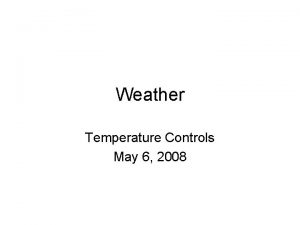Chapter 17 3 Temperature Controls A temperature control







- Slides: 7

Chapter 17. 3 Temperature Controls

A temperature control is anything that causes temperature to vary from place to place and from time to time. Why Temperatures Vary A major reason for temperature variation is how the sun’s rays hit the Earth. This makes warmer temperatures in the tropics and colder temperatures toward the poles. There are factors other than latitude that play a role of temperature variation – heating of land water, geographic position, cloud cover, and ocean currents are all important.

Different land surfaces absorb different amount of solar energy. Land water drastically absorb solar energy differently. Land Water Land heat more quickly and to higher temperatures than water. Land will also cool more quickly and to lower temperatures than water. Land closer to water will have less temperature extremes than land not close to large bodies of water.

Geographic Position Example: a coastal location that has very strong prevailing winds blowing from the ocean to the shore will have less temperature variation than a coastal location that has strong prevailing winds that blow from the shore to the ocean. Another important geographic feature is mountains. Mountains act as barriers. It can cut off an area from the moderating influence of the ocean.

Altitude The higher the altitude the cooler the place. 2 areas that have the same latitude but different altitudes will have different temperature variation.

Temperature Cover and Albedo is the amount of total radiation reflected by a surface. Clouds have a high albedo, so they reflect a large amount of sunlight that hits them. Clouds will reduce temperatures because they reduce the amount of sunlight an area gets. At night clouds have the opposite effect – they will act like a blanket by reflecting heat back to Earth. Ultimately clouds will reduce the daily temperature range.

World Distribution of Temperature Isotherms are lines that connect points that have the same temperatures on a map. This type of map will not show altitude differences. These maps will show temperature trends and how the different ideas discussed in this chapter influence temperature.
 General controls vs application controls
General controls vs application controls He who controls the past controls the future
He who controls the past controls the future Environmental controls infection control
Environmental controls infection control Iso 27001 soa excel
Iso 27001 soa excel Organizational structure and controls chapter 11
Organizational structure and controls chapter 11 Difference between curie temperature and neel temperature
Difference between curie temperature and neel temperature Difference between curie temperature and neel temperature
Difference between curie temperature and neel temperature Difference between antiferromagnetism and ferrimagnetism
Difference between antiferromagnetism and ferrimagnetism













